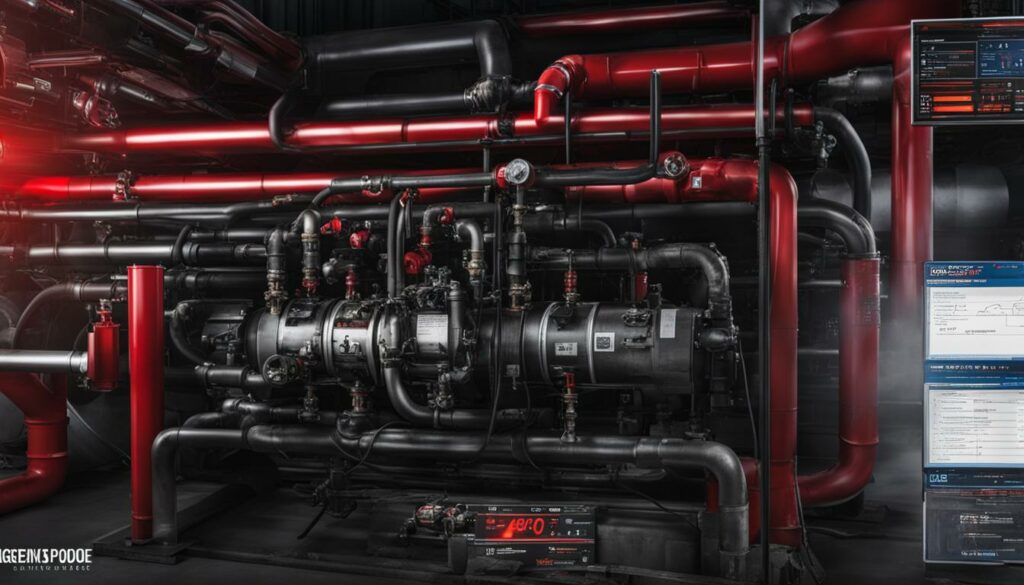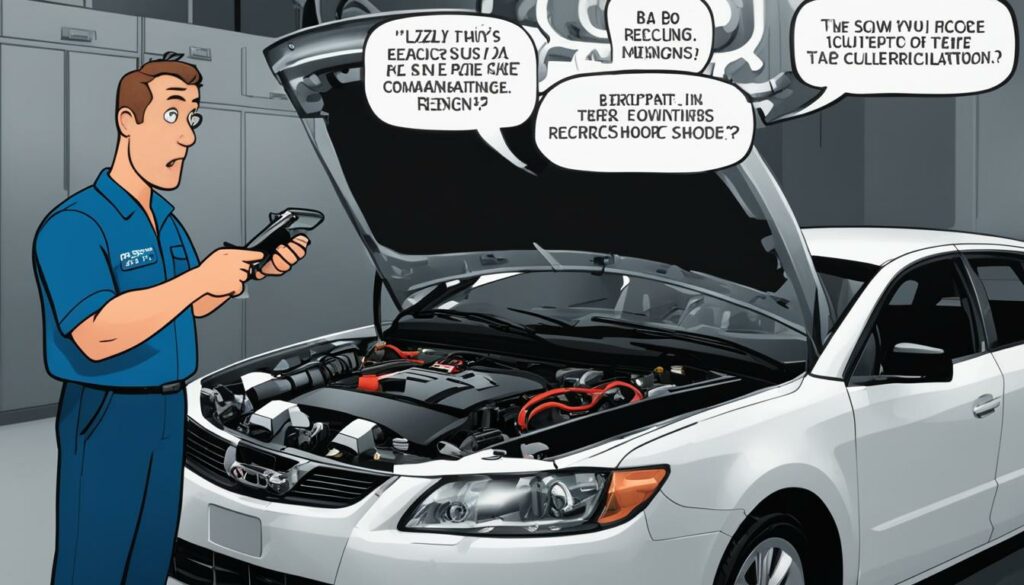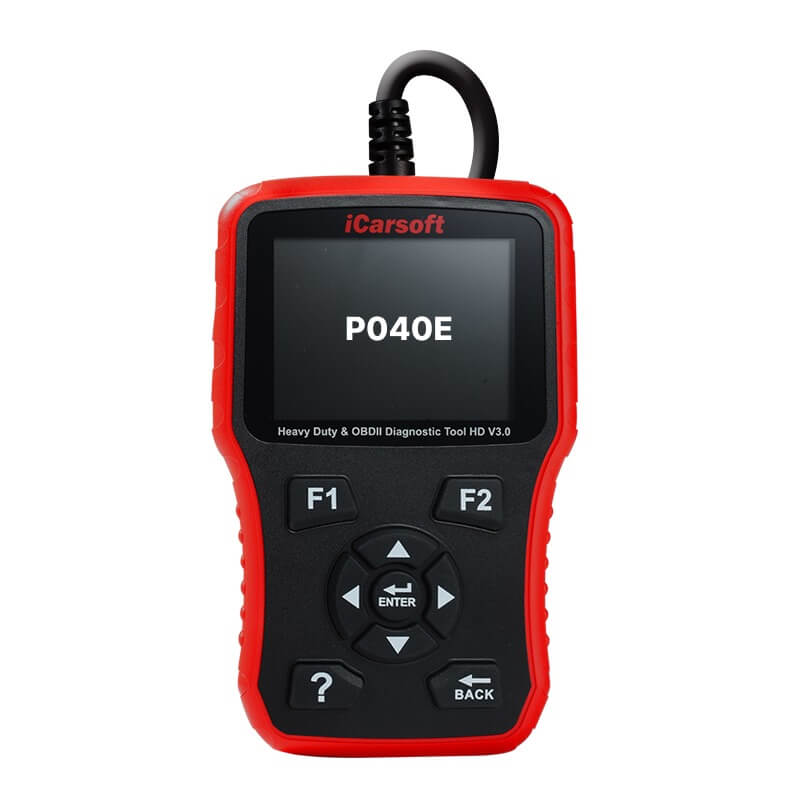P040E – Exhaust Gas Recirculation Temperature Sensor “B” Circuit High
POSTED IN pcodes
Welcome to our article on the P040E fault code. If you’re experiencing issues with the Exhaust Gas Recirculation (EGR) Temperature Sensor “B” Circuit, you’ve come to the right place. This fault code is a generic powertrain code that applies to OBD-II equipped vehicles, indicating a high circuit reading from the EGR temperature sensor.
The EGR temperature sensor is responsible for measuring the temperature of the exhaust gas and increasing resistance with increasing temperature. When the sensor reading is out of range, it can indicate a malfunction in the EGR system, potentially causing issues with emissions and engine performance.
In this article, we’ll discuss the symptoms, causes, and troubleshooting steps for the P040E fault code. Whether you’re a DIY enthusiast or seeking professional assistance, we’ve got you covered. Let’s dive in and get your vehicle back on track!
Key Takeaways:
- The P040E fault code indicates a high circuit reading from the EGR temperature sensor.
- Common symptoms include louder exhaust, emissions test failures, and the appearance of the service engine soon warning light.
- Causes can vary, including issues with the sensor itself, the engine control module, or poor connections.
- Consult a professional mechanic for accurate diagnosis and repair solutions.
- As a last resort, there is an alternative solution of permanently removing the P040E fault code.
Understanding the P040E Fault Code
The P040E fault code indicates a problem with the Exhaust Gas Recirculation (EGR) Temperature Sensor “B” Circuit. This fault code is considered to be of medium severity. It is a generic powertrain code that applies to OBD-II equipped vehicles and signifies that there is a high circuit reading from the EGR temperature sensor. The EGR temperature sensor is responsible for measuring the temperature of the exhaust gas and increasing resistance with increasing temperature. When the sensor reading is out of range, it can indicate a malfunction in the EGR system, potentially causing issues with emissions and engine performance. It is important to address this fault code promptly to prevent further damage to the vehicle and ensure compliance with emission standards.
Along with its technical description and meaning, the severity of the P040E fault code is an important consideration for vehicle owners and mechanics. While a high-severity fault code requires immediate attention, the P040E fault code falls into the medium severity category. This means that it should not be ignored, as it can lead to complications with emissions and engine performance, but it may not necessarily indicate a catastrophic failure.
Buy tested tuning file for Adblue / EGR / DPF / Adblue off now!
Understanding the technical aspects of the P040E fault code is crucial in diagnosing and resolving the issue. The code indicates a high circuit reading from the exhaust gas recirculation temperature sensor. This sensor is responsible for measuring the temperature of the exhaust gas as it passes through the EGR system. By monitoring the temperature, the sensor helps regulate the flow of exhaust gas to control emissions and optimize engine performance.
When the sensor reading is out of range, it suggests a malfunction within the EGR system. This can be caused by various factors, including sensor defects, wiring issues, or problems with the engine control module. Addressing the P040E fault code requires a thorough diagnostic process to identify the exact cause and implement the appropriate solution.
By understanding the technical intricacies of the P040E fault code, vehicle owners and mechanics can take the necessary steps to diagnose, repair, and prevent further damage. Prompt attention to this fault code is essential to maintain optimal engine performance, minimize emissions, and ensure the longevity of the vehicle.

Symptoms of P040E – Exhaust Gas Recirculation Temperature Sensor “B” Circuit High
The P040E fault code can exhibit several symptoms, including:
- Louder exhaust: You may notice that your vehicle’s exhaust sound is louder than usual.
- Failure of emissions or smog tests: If you fail an emissions or smog test, it could be due to the high circuit reading from the EGR temperature sensor.
- Strong exhaust smells: Unusual and strong smells coming from the exhaust system can be indicative of an issue with the EGR system.
- Abnormal engine noises: Strange noises like knocking, rattling, or pinging can occur when the EGR temperature sensor circuit is high.
- Illumination of the service engine soon warning light: A lit service engine soon warning light on your dashboard can be a sign of an EGR system malfunction.
These symptoms should not be ignored, as they indicate potential issues with the EGR system. It is important to address the P040E fault code promptly to prevent further damage to your vehicle and ensure compliance with emission standards.
The P040E fault code can be caused by various factors, including:
- Quirks in the connector: Issues with the connection between the EGR temperature sensor and the engine control module can result in the high circuit reading.
- Malfunctioning engine control module: A faulty engine control module may not be accurately reading the signals from the EGR temperature sensor.
- Defaults in the EGR temperature sensor: If the EGR temperature sensor itself is not functioning properly, it can cause the P040E fault code.
- Leakage in the EGR temperature sensor gasket: Any leakage in the gasket that seals the EGR temperature sensor can lead to improper readings and trigger the fault code.
- Cracked or leaking exhaust pipe where the sensor is mounted: Damage to the exhaust pipe near the EGR temperature sensor can affect its readings and cause the fault code.
- Burnt wiring harness: Burnt or damaged wiring harnesses can disrupt the electrical signals between the EGR temperature sensor and the engine control module.
- Poor connections: Loose or corroded connections between the EGR temperature sensor and the engine control module can contribute to the fault code.
- Defects in the EGR temperature sensor: Any defects in the EGR temperature sensor itself can result in inaccurate readings and trigger the fault code.
- Opened or shorted harness for the exhaust gas recirculation temperature sensor: Wiring harnesses with open or shorted circuits can cause problems with the EGR temperature sensor circuit and result in the fault code.
Troubleshooting P040E – Exhaust Gas Recirculation Temperature Sensor “B” Circuit High
When encountering the P040E fault code, troubleshooting the issue is crucial to identify the underlying problem and find an appropriate solution. By following specific steps tailored to your vehicle’s make and model, you can effectively diagnose and address the issue. Here are some general diagnostic steps to guide you:
- Visually inspect the EGR temperature sensor and the surrounding EGR system. Look for any signs of exhaust leaks, such as soot deposits or damaged gaskets. Addressing these leaks may resolve the fault code.
- Check the EGR temperature sensor and its harness for any visible issues. Specifically, look for high-temperature-induced damage or black soot that could indicate an exhaust leak. Clean the sensor and its harness if necessary.
- Verify the condition of the EGR system itself. Clean the EGR system or temperature sensor, if applicable, to ensure proper operation and eliminate any obstructions that may be causing the fault code.
To fix the P040E fault code, several repair solutions may be required based on the diagnosis:
- Repair or replace a defective connector that is causing an intermittent connection or wiring issue.
- Replace a faulty engine control module (ECM) if it is unable to receive or interpret accurate data from the EGR temperature sensor.
- Repair or replace any flawed wires or connections within the circuit that are affecting the sensor’s readings.
- Replace or repair the exhaust gas recirculation temperature sensor or its gasket if it is determined to be defective or damaged.
It is important to note that accurate diagnosis and repair solutions may require the expertise of a professional mechanic. Consulting with a qualified technician or using diagnostic tools can ensure an effective resolution to the P040E fault code.
Example Troubleshooting Table:
| Issue | Possible Cause | Solution |
|---|---|---|
| EGR temperature sensor reading out of range | Defective connector | Repair the connector or replace with a new one |
| EGR temperature sensor reading out of range | Faulty engine control module (ECM) | Replace the ECM with a new one |
| EGR temperature sensor reading out of range | Flawed wires or connections | Repair or replace the affected wires or connections |
| EGR temperature sensor reading out of range | Defective or damaged EGR temperature sensor or gasket | Replace the EGR temperature sensor or its gasket |
Follow these troubleshooting steps and consult a professional if needed to effectively address and resolve the P040E fault code.

Conclusion
In conclusion, the P040E fault code indicates a problem with the Exhaust Gas Recirculation (EGR) Temperature Sensor “B” Circuit, which can have detrimental effects on your vehicle’s emissions and engine performance. Addressing this fault code promptly is crucial to ensure compliance with emission standards and avoid further damage to your vehicle.
For accurate diagnosis and effective repair solutions, it is highly recommended to seek professional assistance. A qualified mechanic will have the expertise and diagnostic tools to identify the specific cause of the P040E fault code and provide the most appropriate repairs. Professional assistance will help you avoid any costly mistakes and ensure that your vehicle is back on the road in optimal condition.
In cases where professional assistance may not be available or feasible, there is an alternative solution of permanently removing this specific Pcode by uploading the Engine Control Unit (ECU) file to a specialized portal. However, it is crucial to note that this alternative solution should be considered as a last resort, and it is always advisable to consult with a professional mechanic before proceeding with any modifications to your vehicle’s ECU.
Remember, taking swift action and addressing the P040E fault code promptly will not only help maintain your vehicle’s performance and emissions but also contribute to a cleaner and healthier environment.
FAQ
What does the P040E fault code indicate?
The P040E fault code indicates a problem with the Exhaust Gas Recirculation (EGR) Temperature Sensor “B” Circuit. It signifies a high circuit reading from the EGR temperature sensor.
What is the severity of the P040E fault code?
The P040E fault code is considered to be of medium severity. It should be addressed promptly to prevent further damage to the vehicle and ensure compliance with emission standards.
What are the symptoms of the P040E fault code?
Common symptoms of the P040E fault code include a louder exhaust, failure of emissions or smog tests, strong exhaust smells, abnormal engine noises such as knocking or pinging, and the illumination of the service engine soon warning light.
What are the common causes of the P040E fault code?
The P040E fault code can be caused by issues with the sensor itself, a malfunctioning engine control module, poor connections, defects in the sensor or its wiring, and more.
How can I troubleshoot the P040E fault code?
Troubleshooting steps for the P040E fault code may include visually inspecting the sensor and EGR system for any issues, checking the sensor and its harness for damage, and cleaning the EGR system or temperature sensor if necessary. It is recommended to consult with a professional mechanic for accurate diagnosis and repair solutions.
Is professional assistance recommended for fixing the P040E fault code?
Yes, it is recommended to consult with a professional mechanic for accurate diagnosis and repair solutions for the P040E fault code. They have the knowledge and experience to properly diagnose and fix the issue.
Is there an alternative solution for permanently removing the P040E fault code?
Yes, there is an alternative solution of permanently removing this specific Pcode by uploading the Engine Control Unit (ECU) file to a specific portal. However, this should be considered as a last resort and it is advisable to consult with a professional mechanic before proceeding.


